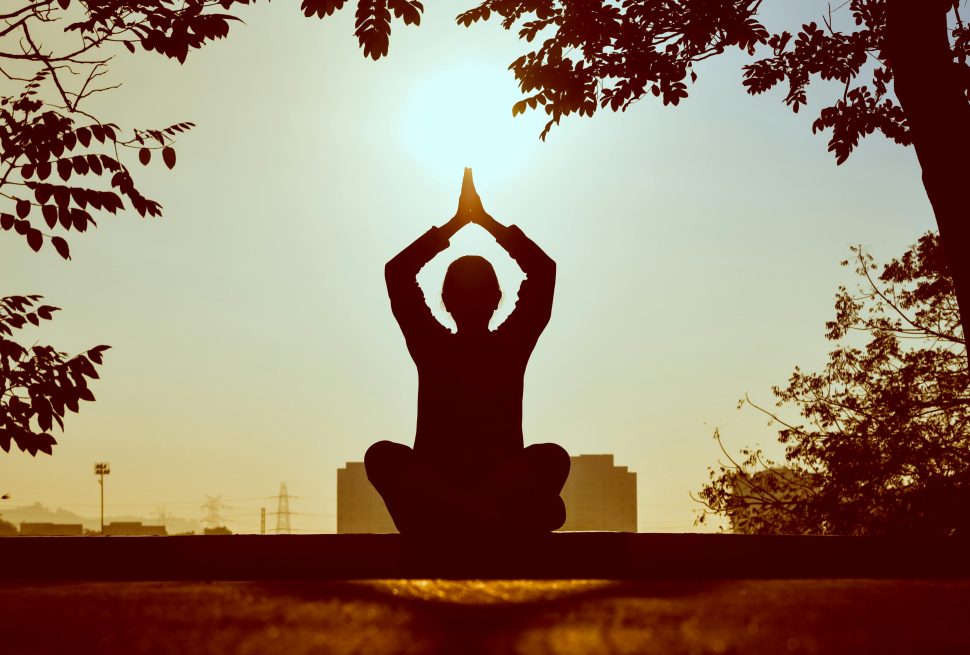During a busy day, we often think of things that went well at some time or we plan something on our head or think about something, except for work. We may call it a fantasy or daydreaming.
A bit of time passes and we get snapped to reality, the same place, same people, same life. A series of realization flows through our veins, along with a sheer sadness that comes along with it.
A lot of us can’t manage time for hour long gym sessions or long walks or something that makes our time pass and takes our worries away, without having any impact on our physical or mental health. One of the similarities between all of us is that we wish to have a break, a fraction of time for each day, away from the life we have been living since all these years.
For such a life, the uneasy looking position’s work, “Yoga” comes in handy. What is yoga? How does it work? Along with some frequently asked questions related to Yoga. Let’s delve into it.
Yoga
Wikipedia says, “Yoga” is a group of physical, mental, and spiritual practices or disciplines which originated in ancient India and aim to control (yoke) and still the mind, recognizing a detached witness-consciousness untouched by the mind (Chitta) and mundane suffering (Duḥkha). There is a wide variety of schools of yoga, practices, and goals in Hinduism, Buddhism, and Jainism, and traditional and modern yoga is practiced worldwide.
However, my belief is that Yoga is a “gift”. Wherever it originated from, whoever practiced it first, it is a simple yet more effective than multiple drugs combined all together. All you need is discipline to be its practitioner.
Finding peace within self can be tougher than acquiring the gold present all around this globe. With a lot of things happening throughout my life, I have started to follow Yoga and meditation myself too. From the books I have read and words that were said to me, philosophies included in yoga that are the ultimate pathway for us to the journey of peacefulness.
Best Yoga Hour
Finding the ideal time to practice yoga can significantly impact the benefits you receive. Traditionally, yoga would be practiced early in the morning during the “Brahma Muhurta,” which is roughly an hour and a half before sunrise. This time is believed to be the most serene and conducive to achieving a calm mind and focused practice. However, it is important to consider personal schedules and preferences.
Morning yoga sessions are advantageous as they invigorate the body, preparing it for the day ahead. Practicing yoga in the morning also promotes a sense of discipline and regularity. Moreover, morning air is usually fresh and clean, enhancing the breathing exercises performed during yoga.
On the other hand, evening yoga can be equally beneficial, especially for those who struggle to find time in the morning. Evening sessions help in unwinding after a long day, alleviating stress, and promoting better sleep. Additionally, muscles tend to be more flexible in the evening, reducing the risk of injuries during practice.
Ultimately, the best hour for yoga depends on individual lifestyle and body rhythm. Whether in the morning or evening, consistency is key to reaping the full benefits of yoga.
A Normal Yoga Routine
A typical yoga routine can vary in length and intensity, depending on individual goals and fitness levels. However, a balanced routine generally includes warm-up exercises, a series of postures (asanas), breath control (pranayama), and relaxation. Here is an example of a normal yoga routine:
Warm-Up (2-5 minutes)
- Shoulder Rolls: Roll shoulders forward and backward to release tension.
- Cat-Cow Stretch: Transition between arching and rounding the back to warm up the spine.
Best Yoga Practices
Adopting best practices ensures a safe and effective experience. Here are some essential tips:
- Start with a Warm-Up: Firstly, warming up is crucial to prepare the body for more intense postures. Simple stretches and gentle movements, such as shoulder rolls and cat-cow stretches, increase blood flow to the muscles, thereby reducing the risk of strains and injuries.
- Focus on Breath Control: Secondly, breath control, or “Pranayama,” is a fundamental aspect of yoga. It involves controlled breathing techniques that enhance concentration, reduce stress, and improve lung capacity. Furthermore, integrating breath control with postures maximizes the effectiveness of each pose.
- Maintain Proper Alignment: Additionally, correct alignment in yoga postures is vital to prevent injuries and gain maximum benefits. Beginners, in particular, should consider attending classes or watching instructional videos to understand proper alignment. Over time, body awareness improves, thus making it easier to maintain correct postures.
- Progress Gradually: Moreover, yoga is not about pushing the body to its limits. Therefore, it is essential to progress gradually, allowing the body to adapt to new poses. Attempting advanced postures without adequate preparation can lead to injuries.
- Stay Hydrated: Additionally, hydration is important before, during, and after yoga sessions. Drinking water helps in maintaining energy levels and aids in detoxification.
- Practice Regularly: Furthermore, consistency is crucial in yoga. Regular practice, even if it’s for a short duration, yields better results than sporadic, intense sessions.
- Listen to Your Body: Lastly, yoga encourages tuning into the body’s signals. Consequently, it is important to recognize when to push forward and when to rest. Overexertion can lead to fatigue and injuries.
By adhering to these best practices, practitioners can enhance their yoga experience and achieve a harmonious balance between mind and body.
Sun Salutations (Surya Namaskar) (2-3 minutes)
Sun Salutations are a series of 12 postures performed in a sequence, often repeated multiple times. They serve as a full-body warm-up, enhancing flexibility and strength.
Standing Poses (3-5 minutes)
- Warrior I (Virabhadrasana I): Step one foot back, bend the front knee, and raise arms overhead.
- Warrior II (Virabhadrasana II): Extend arms parallel to the floor, looking over the front hand.
- Triangle Pose (Trikonasana): Extend arms and lean forward, touching the floor or shin, while the other arm reaches upward.
- Mountain Pose (Tandasana): Stand tall with feet together, grounding through the feet.
Seated Poses (3-5 minutes)
- Butterfly Pose (Baddha Konasana): Sit with feet together, knees bent, and press them towards the floor.
- Seated Spinal Twist (Ardha Matsyendrasana): Twist the torso while seated, with one leg bent and the other crossed over.
- Seated Forward Bend (Paschimottanasana): Sit with legs extended, reaching forward to touch toes.
Prone and Supine Poses (3-5 minutes)
- Bridge Pose (Setu Bandhasana): Lie on the back with knees bent, lifting hips towards the ceiling.
- Corpse Pose (Savasana): Lie flat on the back, arms by the sides, and relax completely.\
- Cobra Pose (Bhujangasana): Lie on the stomach and lift the chest off the floor, keeping elbows bent.
Pranayama (5-10 minutes)
- Belly Breathing (Diaphragmatic Breathing): Breathe deeply into the abdomen, allowing it to rise and fall naturally.
- Alternate Nostril Breathing (Nadi Shodhana): Use fingers to close one nostril while inhaling and exhaling through the other.
After the various positions are tried out, it is necessary to relax, give some time for the muscles and bones to rest along with the heart and the brain. Scanning the self from inside to outside, head to toe, feeling the pains and joy each body provides as you get soaked with your own deep breathings.
The final state to a good yoga practice is meditation and relaxation for as many minutes as you can allocate yourself to.
This routine can be adjusted based on time constraints and personal preferences. The key is to maintain a balance between different types of postures and to practice with mindfulness.
Yoga Philosophy and Lifestyle
Incorporating Yoga Philosophy into Life:

The balance between the mind, body and spirit is what yoga means. Like Oogway from the Kung Fu Panda series says, “Finally Inner Peace”. This can be achieved when one encompasses the principles of yoga and it’s practices in daily life. Those include:
- Ahimsa: Replace negative self-talk with affirmations and choose respectful communication.
- Satya: Align your actions with your values and strive for clear communication.
- Asteya: Respect boundaries and appreciate what you have, don’t take advantage of others’ time or energy.
- Aparigraha: Let go of the need to control and possess. Practice gratitude for the present moment.
- Santosha: Find joy in life’s simple pleasures and avoid comparing yourself to others.
The Yamas and Niyamas:
The Yamas: They are five ethical observances that focus on self-restraint and cultivating positive social behaviors.
- Ahimsa: Speak with kindness, avoid gossip, and treat others with respect.
- Satya: Live authentically by being honest in your words and actions.
- Asteya : Learn to appreciate what you already have.
- Brahmacharya : Don’t overindulge in anything, whether it’s food, substances, or work.
- Aparigraha: Let go of the need to control and possess.
The Niyamas: These are five self-disciplines that promote introspection, mindfulness, and positive habits.
- Saucha: Maintain a clean physical environment and cultivate a pure mind free of negativity. Practice healthy habits and positive thoughts.
- Santosha: Find inner peace and satisfaction with your life. Appreciate simple joys and avoid comparing yourself to others.
- Tapas: Develop self-discipline and commitment to your practice. Set achievable goals and work towards them, both in yoga and other areas of life.
- Svadhyaya: Engage in self-reflection and continuous learning. This can involve reading yoga philosophy, exploring meditation techniques, or simply taking time for introspection. Seek to understand yourself better.
- Ishvarapranidhana: Accept what’s beyond your control and trust in a higher power (whatever that means to you). Practice acceptance and find peace in surrendering to the present moment.
Yoga Trends and adaptability
1. Yoga and Technology: Apps, Gadgets, and Online Classes
Currently, if we visit the app store and search for yoga tools, we might run across various tools and applications designed to enhance the yoga experience of a user. We can see multiple posts dedicated to yoga or at least something related with such practices if we scroll through our social media’s news feed. Technology is supposed to make our lives easier but we find it hard to cope up with our world and live through it. Yoga is something that makes life a bit more tolerable.
Apps such as: Simply Yoga, 5 min yoga, Alo Moves, Yoga | Down Dogs, Asana Rebel and many more can help motivate people to participate in the Yoga practices on a regular basis.
2. Yoga in Universities:
My cousin is currently studying civil engineering from an engineering college, here in the capital of Nepal. He has class early in the morning at around 8 am and the class ends after 5 pm. The contents are too much in number, plus the assignments and deadlines which makes his along with his fellow mate’s life harsh. So, their college came up with an approach to add Yoga in their curriculum to enhance their mental wellness and ensure their safety from various problems that may arise due to work overload.
On asking him about this step taken by college, my cousin replied, “Well, I have work anyways, too much in fact but practicing it does help to keep me be active throughout the entire lectures.” So, my take is, yoga does help to some extent.
FAQ
Q: How often should I practice yoga?
Aim for 3-4 sessions per week for optimal benefits, but even daily 10-25 minute practices yield results.
Q: How do I ensure proper form?
Observe others or utilize online resources (like YouTube videos) to learn proper technique. Consider attending in-person or online yoga classes for instructor guidance and corrections. A mirror can also help you check alignment.
Q: Can I practice yoga with a medical condition?
Yoga can be adapted for many conditions, but consulting a healthcare professional beforehand is crucial. Certain poses might require modifications to suit your specific needs.
Q: Do I need special equipment?
A comfortable space, loose clothing, and your own body are all you truly need. Most poses require no equipment.
Q: Can yoga help with weight loss?
Increased physical activity, improved metabolism, and stress reduction (leading to healthier eating) can all contribute to weight loss with this practice.
Q: Is yoga for everyone?
Absolutely! Various asanas and stretching styles and modifications cater to children, adults, and seniors.
Q: Can I practice yoga while pregnant?
Prenatal yoga offers benefits for expecting mothers, but consulting a doctor and a certified instructor is vital.
Q: What should I eat before and after yoga?
Practice yoga on an empty stomach or with a light snack an hour beforehand. Replenish your body after with a balanced meal containing protein, carbs, and healthy fats. Don’t forget to rehydrate after sweating it out!
Conclusion
In conclusion, yoga is an important practice that offers various benefits on an emotional level as well as physical and mental health. By understanding it’s aspect , adopting essential practices, and following a balanced routine, yoga practitioners can boost their morale, have a slightly better tolerance for day-to-day life, and build resilience for the challenging days. Whether a beginner or an experienced practitioner, this practice provides a path to a healthier, more peaceful life. For more blogs on this topic, meditation, mental health, and yoga trek retreats, visit our blog page. Additionally, for yoga retreat packages, visit our page on manasukh. We are proud of who you are, how you are, and your interest in enhancing your well-being by taking the first step towards personal growth.




